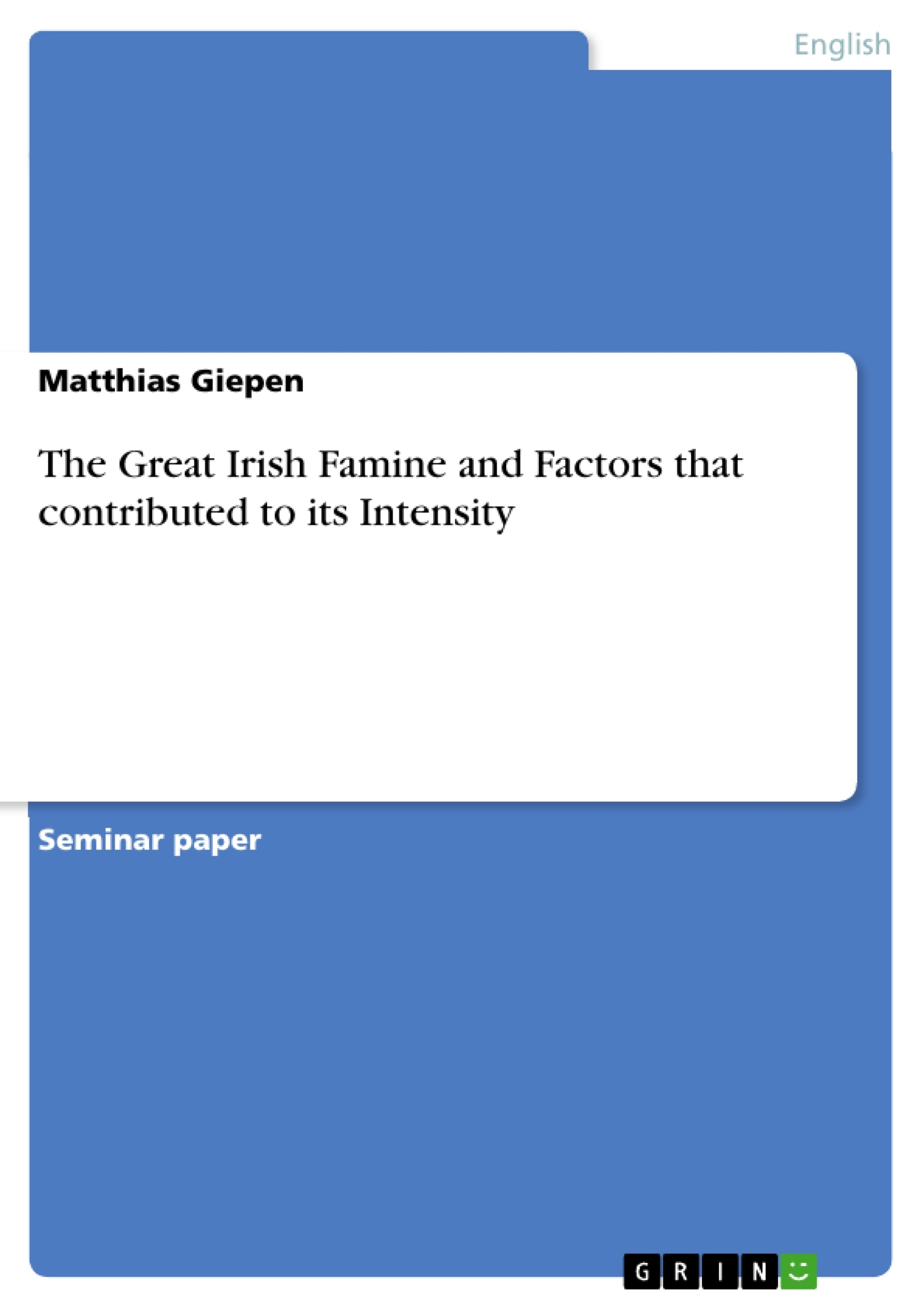The aim of this paper is to find out which factors contributed most to the intensity of the Great Irish Famine and to evaluate the measures of the two governments that had to deal with the Great Famine.
Firstly, a chronological overview is given. After this, several influencing factors like the pre-Famine situation in Ireland or government measures will be reviewed and evaluated.
Table of Contents
- Introduction
- Chronological Overview
- Influencing Factors
- Demographic Factor
- The use of the Potato
- The Poverty Relief System
- Government Action
- Government Action under Prime Minister Robert Peel
- Immediate Measures
- The Repeal of the Corn Laws
- The Relief Commission and the Board of Works
- Public Works
- Government Action under Prime Minister John Russell
- The Blight Returns
- Public Works
- Soup Kitchens
- Workhouses
- Government Action under Prime Minister Robert Peel
Objectives and Key Themes
This paper aims to identify the factors contributing to the intensity of the Great Irish Famine and evaluate the government responses. It explores the chronological progression of the famine, analyzing the effectiveness of various policy initiatives.
- The impact of the potato blight on Ireland's population.
- Analysis of pre-existing socio-economic conditions in Ireland.
- Evaluation of the government's response under Robert Peel and John Russell.
- The role of poverty relief systems in mitigating the famine's effects.
- The consequences of the famine, including mass emigration.
Chapter Summaries
Introduction: This chapter sets the stage by contextualizing the Great Irish Famine within the broader history of famines, both in Ireland and globally. It highlights the disproportionate attention given to the Great Famine compared to earlier, potentially more devastating events in Ireland. The chapter emphasizes the famine's significance as a demographic case study and its role in shaping Irish nationalist narratives, while acknowledging Ireland's position within the relatively prosperous United Kingdom. It introduces the paper's aim of analyzing contributing factors to the famine's intensity and evaluating government responses.
Chronological Overview: This chapter provides a year-by-year account of the Great Irish Famine, starting with the arrival of the potato blight in 1845. It details the initial government response under Robert Peel, the devastating impact of the blight in 1846, and the contrasting approaches of the subsequent government under John Russell. The chapter documents the escalating crisis, including food shortages, price increases, rising crime rates, and the eventual implementation of various relief measures such as public works and soup kitchens. It also notes the recurring blight and its impact on subsequent harvests.
Influencing Factors: This chapter delves into the factors that exacerbated the severity of the Great Irish Famine beyond the potato blight itself. It anticipates an examination of Ireland's pre-famine socio-economic conditions, including factors such as population density, overreliance on the potato crop, and the inadequacies of the existing poverty relief system. These factors are presented as key contributors to the famine's devastating impact and help to frame the subsequent analysis of government actions.
Keywords
Great Irish Famine, potato blight, phythophtera infestans, Robert Peel, John Russell, government response, poverty relief, emigration, demographic factors, socio-economic conditions, Irish history.
Great Irish Famine: A Comprehensive Language Preview - FAQ
What is this document?
This document is a comprehensive language preview providing an overview of a paper analyzing the Great Irish Famine. It includes the table of contents, objectives and key themes, chapter summaries, and keywords.
What topics are covered in the Table of Contents?
The table of contents covers an introduction, a chronological overview of the famine, influencing factors (demographic factors, potato reliance, poverty relief systems), and government actions under Prime Ministers Robert Peel and John Russell (including specific measures taken).
What are the main objectives and key themes of the paper?
The paper aims to identify factors contributing to the famine's intensity and evaluate government responses. Key themes include the impact of the potato blight, pre-existing socio-economic conditions in Ireland, government responses under Peel and Russell, the role of poverty relief, and the consequences (including emigration).
What does the "Chapter Summaries" section include?
The chapter summaries provide detailed overviews of each chapter. The introduction contextualizes the famine historically. The chronological overview details the famine year by year. The section on influencing factors previews an examination of pre-existing socio-economic conditions that exacerbated the crisis.
What are the key words associated with this paper?
Key words include: Great Irish Famine, potato blight, phythophthora infestans, Robert Peel, John Russell, government response, poverty relief, emigration, demographic factors, socio-economic conditions, and Irish history.
What is the focus of the analysis on government actions?
The analysis focuses on comparing and contrasting the governmental responses under Prime Minister Robert Peel and Prime Minister John Russell, examining the effectiveness of their various policy initiatives in mitigating the famine's effects.
What role does the potato play in the analysis?
The overreliance on the potato as a staple crop in Ireland is identified as a crucial pre-existing condition significantly exacerbating the impact of the potato blight and the resulting famine.
What other factors beyond the potato blight are considered?
Beyond the blight, the analysis considers pre-existing socio-economic conditions such as population density, the inadequacy of the existing poverty relief system, and other demographic factors as key contributors to the famine's severity.
What is the significance of the Great Irish Famine according to the document?
The document highlights the famine's significance as a major demographic event, its influence on Irish nationalist narratives, and its contrast with Ireland's position within the relatively prosperous United Kingdom. It is presented as a crucial case study for understanding the impact of famine and government response.
- Citation du texte
- Matthias Giepen (Auteur), 2010, The Great Irish Famine and Factors that contributed to its Intensity, Munich, GRIN Verlag, https://www.grin.com/document/166011



